Welcome to a culinary journey that promises flavor, nutrition, and ease – introducing the ultimate Crispy Roasted Tofu Buddha Bowl with Homemade Pineapple Teriyaki Sauce. This isn’t just a meal; it’s a vibrant experience packed into a single bowl, designed to nourish your body and delight your taste buds. Imagine perfectly oven-roasted tofu, crispy on the outside and tender within, nestled amongst a colorful medley of fresh, wholesome vegetables and fluffy quinoa, all generously drizzled with an irresistible, tangy-sweet homemade pineapple teriyaki sauce. It’s a plant-based powerhouse that proves healthy eating can be both simple and incredibly delicious.
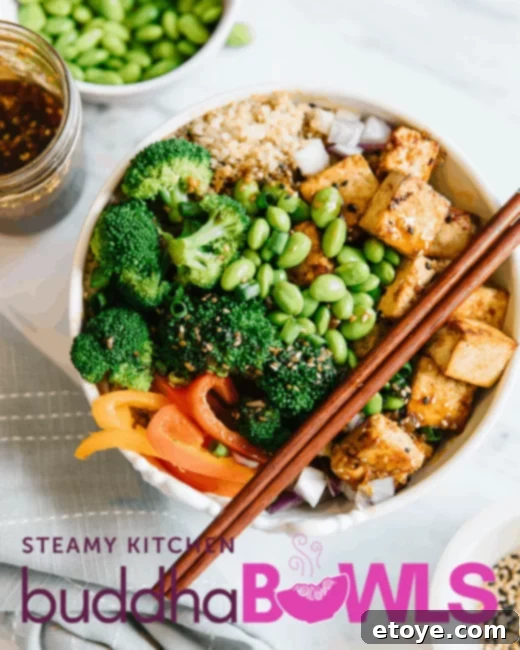
Understanding the Buddha Bowl Concept
The term “Buddha Bowl” has captured the hearts of healthy eaters worldwide, and for good reason. More than just a meal served in a bowl, it represents a philosophy of balanced eating. A Buddha Bowl is typically a generous, well-rounded meal, overflowing with wholesome ingredients, so full and shapely that it’s said to resemble the Buddha’s contented belly. These bowls are a celebration of vibrant produce, hearty grains, lean proteins, and flavorful dressings, all coming together in perfect harmony.
At its core, a Buddha Bowl is designed to provide a comprehensive range of nutrients in one convenient dish. It’s an excellent way to ensure you’re getting a diverse array of vitamins, minerals, fiber, and protein. Furthermore, the inherent versatility of Buddha Bowls makes them an ideal choice for meal prepping, allowing you to customize ingredients based on seasonal availability, dietary preferences, or whatever you have on hand in your pantry and refrigerator. They are perfect for anyone seeking a wholesome, satisfying, and visually appealing meal that supports a healthy lifestyle.
The Core Components of a Balanced Buddha Bowl
Building an exceptional Buddha Bowl follows a simple yet flexible formula, ensuring a delicious and nutritious outcome every time. Think of it as a creative culinary canvas where each element plays a crucial role:
- The Foundation: Grains or Greens. This is your base, providing essential carbohydrates and fiber. Options range from hearty grains like quinoa or rice to a bed of fresh, leafy greens.
- Vibrant Vegetables: Roasted or Fresh. Load up on a variety of colorful vegetables for vitamins, antioxidants, and textural contrast. Roasting brings out incredible natural sweetness and depth of flavor.
- Protein Powerhouse: Lean and Satisfying. A key component for satiety and muscle health. Tofu, tempeh, chicken, fish, or legumes are excellent choices.
- The Flavor Unleasher: A Delectable Sauce or Dressing. This ties all the elements together, adding moisture, richness, and a burst of flavor. Homemade sauces are always recommended for freshness and control over ingredients.
- The Essential Crunch: Texture and Delight. Don’t forget a topping that adds a satisfying crunch, enhancing the eating experience. Nuts, seeds, or crispy fried onions are popular options.
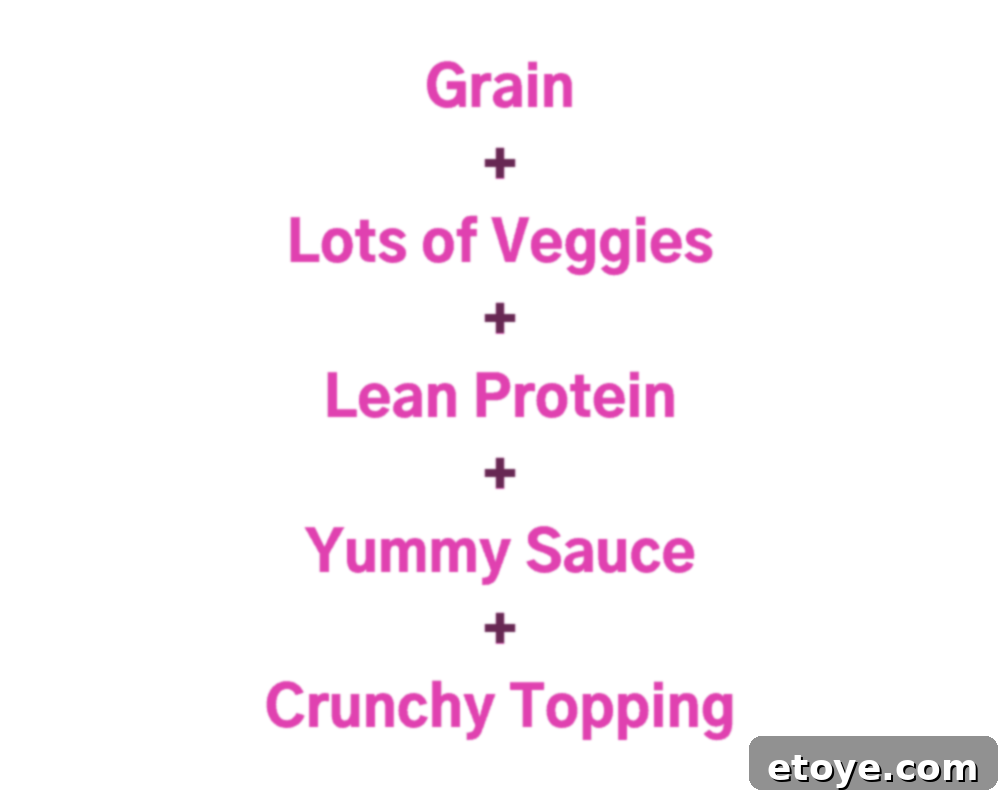
Crafting Your Tofu Buddha Bowl: A Step-by-Step Guide
Our specific Buddha Bowl recipe focuses on a harmonious blend of crispy roasted tofu, a colorful array of oven-baked vegetables, fluffy quinoa, and a show-stopping homemade pineapple teriyaki sauce. Each component is designed for maximum flavor and ease of preparation, making this an ideal meal for busy weeknights or a healthy meal prep option.
Grains: The Foundation of Flavor and Energy
For this recipe, we’ve chosen quinoa as our grain base, and for good reason. Quinoa is a nutritional superstar, a complete protein containing all nine essential amino acids, making it a fantastic choice for plant-based diets. It’s also rich in fiber, iron, magnesium, and B vitamins. Its slightly nutty flavor and fluffy texture provide a perfect canvas for the other ingredients in our bowl.
While quinoa is highly recommended, feel free to adapt this component to your preferences or what you have on hand. Other excellent grain options include:
- Brown Rice: Offers a chewy texture and earthy flavor, packed with fiber.
- White Rice: A lighter option, quick to cook and readily available.
- Couscous: An extremely quick-cooking grain, ideal for when you’re short on time.
- Farro: A hearty, ancient grain with a distinct nutty flavor and satisfying chewiness.
Alternatively, for a lighter, low-carb option, you could even use a generous bed of fresh spinach or mixed greens as your base, or a combination of both grains and greens for added complexity and nutrients.
Vibrant Vegetables: Roasting for Maximum Taste
The beauty of a Buddha Bowl lies in its vibrant colors and diverse textures, largely contributed by the vegetables. Roasting vegetables is a game-changer; it caramelizes their natural sugars, intensifying their flavors and adding a delightful tenderness. For this recipe, we highly recommend:
- Broccoli Florets: Roasting transforms broccoli into a tender, slightly charred delight. Rich in Vitamin C and K.
- Bell Pepper (Red, Yellow, or Orange): Adds a sweet and vibrant crunch. Bell peppers are excellent sources of Vitamin A and C.
- Red Onion: Becomes sweet and mellow when roasted, offering a subtle savory note.
- Edamame: Cooked edamame (microwavable or frozen and boiled) provides an easy boost of plant-based protein and fiber, along with a satisfying bite.
Don’t hesitate to personalize your vegetable selection! Seasonal vegetables are always a fantastic choice. Consider adding sweet potatoes, carrots, zucchini, asparagus, or Brussels sprouts. The key is to cut them into similar-sized pieces to ensure even cooking, then toss them with a good quality olive oil, salt, and pepper before roasting for optimal flavor.
Perfectly Roasted Tofu: Crispy, Flavorful Protein
Tofu is the star protein of this Buddha Bowl, and when prepared correctly, it transforms into incredibly crispy, satisfying bites that soak up all the delicious sauce. The secret to crispy tofu lies in proper pressing. Extra-firm tofu is best for roasting. Pressing removes excess water, allowing the tofu to crisp up beautifully in the oven.
If tofu isn’t your preference, this bowl is incredibly adaptable. You can easily substitute it with other lean proteins such as:
- Roasted Chicken or Turkey: Use leftover cooked poultry or quickly roast some chicken breasts.
- Cooked Shrimp: A quick-cooking protein that adds a delicate flavor.
- Chickpeas or Black Beans: Roasted or simply rinsed and added, these legumes offer a great source of fiber and protein.
- Tempeh: Another fermented soy product with a nutty flavor and firm texture, great for absorbing marinades.
The Star Sauce: Homemade Pineapple Teriyaki
Every great Buddha Bowl needs an exceptional sauce, and our homemade pineapple teriyaki sauce is truly the crowning glory of this dish. Its unique blend of sweet, savory, and tangy flavors perfectly complements the roasted tofu and vegetables. Making your sauce from scratch allows you to control the ingredients, ensuring it’s free from unnecessary additives and high-fructose corn syrup often found in store-bought varieties.
The star ingredient, crushed pineapple (canned works perfectly), provides natural sweetness and a bright, tropical tang. Combined with low-sodium soy sauce, vinegar (apple cider or rice vinegar are excellent), fresh ginger, and garlic, it creates a deeply flavorful and aromatic dressing. This sauce is incredibly versatile – make extra and store it in a mason jar in the refrigerator for up to a week. It’s fantastic over other grain bowls, salads, or as a marinade for grilled proteins.
The Essential Crunch: Adding Texture
Adding a textural element to your Buddha Bowl is crucial for a truly satisfying eating experience. The contrast of crispy toppings against tender grains and vegetables elevates the entire dish. For this recipe, we suggest:
- Toasted Sesame Seeds: A classic choice for teriyaki dishes, offering a delicate crunch and nutty flavor.
- Chia Seeds: While not traditionally “crunchy,” they add a subtle texture and a powerful omega-3 boost.
Other excellent options to experiment with include:
- Chopped Nuts: Almonds, cashews, peanuts, or walnuts provide healthy fats and a significant crunch.
- Crispy Fried Onions: Adds a savory, umami-rich layer of crunch.
- Wonton Strips or Crumbled Tortilla Chips: For a more playful, crunchy texture.
- Roasted Chickpeas: Offers a delightful crispness and additional protein.
A preview of this incredibly appetizing Buddha Bowl:
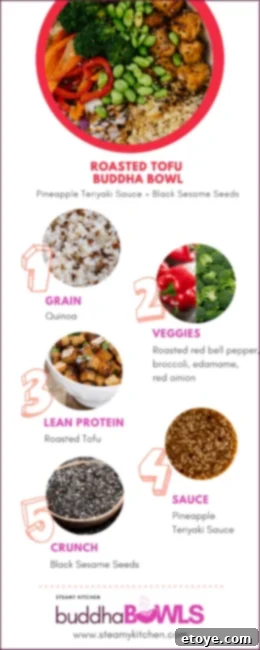
Detailed Preparation Instructions
Preparing this Buddha Bowl is straightforward and efficient, especially since many components can be cooked simultaneously. Here’s a detailed guide to ensure your meal is perfect.
Cooking Fluffy Quinoa
Cooking quinoa is as simple as cooking rice, but the results are even more nutritious. We recommend making a slightly larger batch than needed, as cooked quinoa is excellent for quick meals and salads throughout the week.
You will need:
- 1 cup water
- 2 cups quinoa (for about 4 servings)
- 1/2 teaspoon salt (optional, or to taste)
Instructions for Perfect Quinoa:
- Rinse Thoroughly: Place the quinoa in a fine-mesh sieve and rinse it under cold running water for about 30 seconds. This step is crucial to remove saponins, a natural coating that can give quinoa a bitter taste. Drain well.
- Combine and Boil: In a medium saucepan, combine the rinsed quinoa and water. Bring the mixture to a rolling boil over high heat.
- Simmer and Steam: Once boiling, add salt (if using), then reduce the heat to low, cover the pot tightly, and let it simmer for 15 minutes. Resist the urge to lift the lid!
- Fluff and Rest: After 15 minutes, remove the pot from the heat and let it stand, covered, for another 5-10 minutes. This allows the quinoa to absorb any remaining liquid and steam, resulting in perfectly fluffy grains. Fluff with a fork before serving.
Roasting Tofu and Vegetables to Perfection
Roasting tofu and vegetables together is a time-saving hack that yields incredibly flavorful results. The high heat of the oven crisps the tofu and caramelizes the vegetables, creating depth and texture.
You will need:
- 1 package (around 14-16 oz) extra-firm tofu
- 1/2 head broccoli, cut into very small florets
- 1 bell pepper (any color), cut into thick slices or 1-inch pieces
- 1/2 red onion, cut into 3/4-inch pieces
- 3 tablespoons olive oil (2 tbsp for tofu, 1 tbsp for veggies)
- Salt and freshly ground black pepper to taste
Instructions for Roasting:
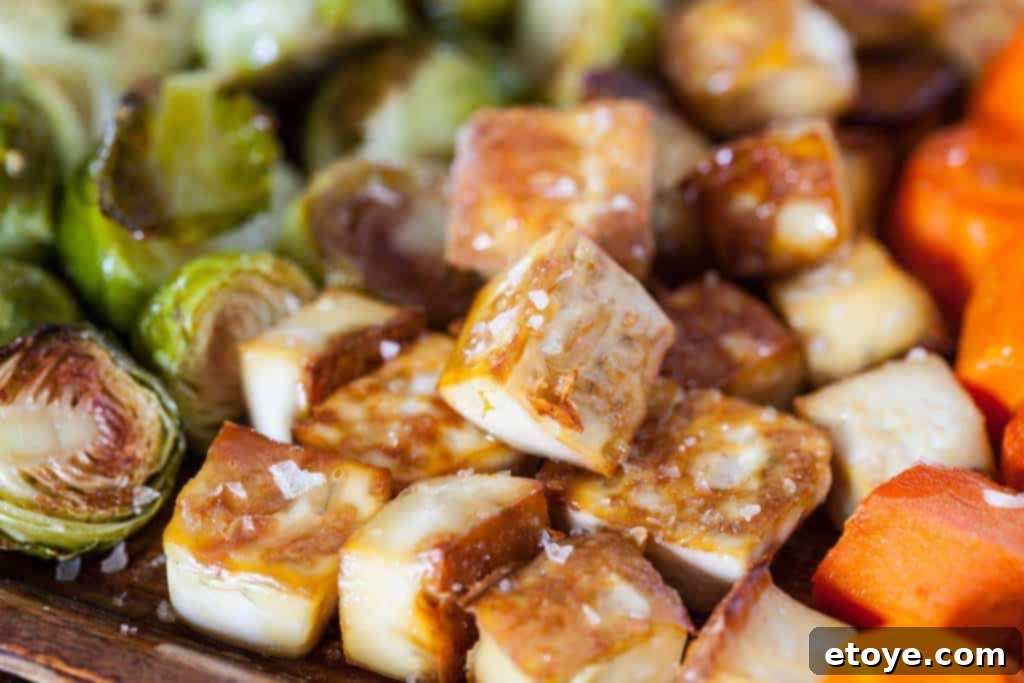
- Preheat Oven & Prep Tofu: Preheat your oven to 400°F (200°C). Drain the tofu thoroughly and press it to remove as much moisture as possible. You can do this by wrapping it in paper towels or a clean kitchen towel and placing a heavy object (like a cast-iron skillet or books) on top for at least 20-30 minutes. The drier the tofu, the crispier it will get.
- Cut and Season Tofu: Once pressed, cut the tofu into 1-inch cubes. Drizzle 2 tablespoons of olive oil onto a baking sheet. Add the tofu cubes and gently shake or toss them to coat. Drizzle a little more olive oil over the top if needed, ensuring all sides are lightly covered. Spread the tofu in a single layer.
- Start Roasting Tofu: Place the tofu in the preheated oven. Begin roasting the tofu while you prepare the vegetables. It will take longer than the veggies to get truly crispy.
- Prepare and Season Vegetables: While the tofu begins roasting, in a large bowl, toss all the remaining vegetables (broccoli, bell pepper, and red onion – remember to hold back the edamame for later) with 1 tablespoon of olive oil, salt, and pepper.
- Add Vegetables to Oven: After about 15-20 minutes of the tofu roasting, remove the tofu baking sheet. Give the tofu cubes a stir or flip them to ensure even browning. On a separate baking sheet, spread the seasoned vegetables in a single layer. Place both baking sheets back into the oven. Continue roasting for another 20-25 minutes, or until the vegetables are tender-crisp and lightly caramelized, and the tofu is golden brown and crispy.
- Cook Edamame: While the tofu and vegetables are roasting, prepare the cooked edamame according to package directions (typically a few minutes in the microwave or boiling water).
For more in-depth tips on oven-roasting tofu and vegetables, including how to achieve extra crispiness and flavor, you might find valuable insights in this Roasted Tofu and Veggies recipe.
Whipping Up the Pineapple Teriyaki Sauce
This sauce is incredibly simple to make and adds a burst of tropical, umami-rich flavor that pulls the entire Buddha Bowl together. The best part? It all comes together in one jar!
Ingredients:
- 1 (8-ounce) can crushed pineapple (undrained, for maximum flavor and moisture)
- 3 tablespoons low-sodium soy sauce (or tamari for gluten-free)
- 1 tablespoon vinegar (apple cider vinegar or unsweetened rice vinegar)
- 1 teaspoon grated fresh ginger (use a microplane grater for best results)
- 1 garlic clove, minced
- 1/4 cup water
- Optional: 1 tablespoon honey or maple syrup for extra sweetness, or a pinch of red pepper flakes for heat.
Instructions for the Sauce:
- Combine Ingredients: In a mason jar or a small bowl, add all the ingredients: crushed pineapple (with its juice), low-sodium soy sauce, vinegar, grated fresh ginger, minced garlic, and water.
- Shake or Whisk: If using a mason jar, secure the lid tightly and shake vigorously until all ingredients are well combined and the sauce is uniform. If using a bowl, whisk thoroughly until smooth.
- Taste and Adjust: Give the sauce a taste. If you prefer it a little sweeter, add a tablespoon of honey or maple syrup. If it’s too salty, a tablespoon or two of water can help dilute it. For a touch of heat, a pinch of red pepper flakes would be a great addition.
Bringing It All Together: Assembling Your Buddha Bowl
Now for the best part – assembling your beautiful Buddha Bowls! This is where all your freshly prepared components come together to create a harmonious and satisfying meal.
- Prepare Your Bowls: Choose four large, inviting bowls.
- Lay the Foundation: Spoon two generous scoops of the fluffy cooked quinoa into each bowl, forming a base.
- Add the Veggies: Arrange a couple of handfuls of your perfectly roasted vegetables and the cooked edamame around the quinoa. Aim for a colorful and appealing presentation.
- Place the Protein: Next, add your crispy roasted tofu (or your chosen lean protein) to the bowl.
- Drizzle the Sauce: Generously drizzle the homemade pineapple teriyaki sauce over all the components. Don’t be shy – this sauce is a flavor hero!
- Sprinkle the Crunch: Finish with a sprinkle of toasted sesame seeds or chia seeds for that essential textural contrast.
Serve immediately and enjoy the satisfying combination of flavors and textures in your homemade Crispy Roasted Tofu Buddha Bowl. This meal is not only incredibly delicious but also a testament to how easy and rewarding healthy, plant-based eating can be.
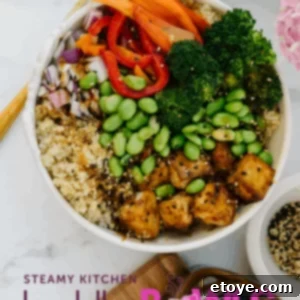
Crispy Roasted Tofu Buddha Bowl with Pineapple Teriyaki Sauce
Pin Recipe
Ingredients
For the Tofu
- 1 package extra firm tofu cut into 1″ pieces, well-pressed
- 2 tbsps olive oil
For the Vegetables
- 1/2 head broccoli cut into very small florets
- 1 bell pepper thick slices or 1-inch pieces
- 1/2 red onion cut into 3/4″ pieces
- 1 tbsp olive oil
- 1 cup cooked edamame
- Salt and pepper to taste
For the Grain
- 1 cup quinoa rinsed
- 2 cups water
- 1/2 tsp salt (optional, for cooking quinoa)
For the Pineapple Teriyaki Sauce
- 1 8-ounce can crushed pineapple undrained
- 3 tablespoons low sodium soy sauce (or tamari for gluten-free)
- 1 tbsp vinegar apple cider vinegar or rice vinegar (unsweetened)
- 1 tsp grated fresh ginger use microplane grater
- 1 garlic clove minced
- 1/4 cup water
- Optional: 1 tbsp honey or maple syrup for sweetness, red pepper flakes for heat.
For the Crunch
- 4 tbsp sesame seeds or other preferred crunchy topping
Instructions
Step 1: Prepare Tofu & Preheat Oven
- Preheat oven to 400°F (200°C).
- Drain the extra-firm tofu and press it very dry using paper towels or a clean kitchen towel. The more moisture you remove, the crispier your tofu will be. Cut the pressed tofu into 1-inch cubes. Drizzle 2 tablespoons of olive oil onto a large baking sheet, add the tofu, and gently toss or shake the baking sheet to coat the tofu cubes evenly. Spread the tofu in a single layer and place it in the preheated oven to begin roasting.
Step 2: Start Cooking Quinoa
- Rinse the quinoa thoroughly under cold water. Combine the rinsed quinoa and 2 cups of water in a pot over high heat and bring to a rolling boil. Add salt (if using), then cover, reduce heat to medium-low, and let it simmer gently for 15 minutes. Once the timer goes off, remove from heat and let stand, covered, for 5-10 minutes. Fluff with a fork.
Step 3: Roast Vegetables
- While the tofu is roasting (after about 15-20 minutes), remove the tofu baking sheet and gently turn/rotate the tofu cubes for even browning. In a separate bowl, toss all the remaining vegetables (broccoli, bell pepper, and red onion – keep the edamame separate for now) with 1 tablespoon of olive oil, salt, and pepper. Spread the seasoned vegetables on a second baking sheet in a single layer. Place both the tofu and vegetable baking sheets back into the oven. Continue roasting for another 20-25 minutes, or until vegetables are tender-crisp and lightly caramelized, and tofu is golden and crispy.
Step 4: Prepare Pineapple Teriyaki Sauce
- In a mason jar (or a small bowl), combine the crushed pineapple (with its juice), low-sodium soy sauce, vinegar, grated fresh ginger, minced garlic, and water. Secure the lid tightly and shake vigorously (or whisk if using a bowl) until all ingredients are well combined. Taste the sauce and adjust seasonings if desired; add a tablespoon of honey or maple syrup for sweetness, or 1-2 tablespoons of water if it’s too salty.
Step 5: Assemble Your Buddha Bowls
- Once the quinoa is fluffed, and the tofu and vegetables are roasted to perfection, it’s time to assemble! In four large, beautiful bowls, spoon two generous scoops of quinoa as your base.
- Next, arrange a couple of handfuls of the roasted vegetables and the cooked edamame around the quinoa. Add your crispy roasted tofu (or preferred lean protein). Generously drizzle with the homemade pineapple teriyaki sauce, and finally, sprinkle with sesame seeds or your chosen crunchy topping. Serve immediately and enjoy!
